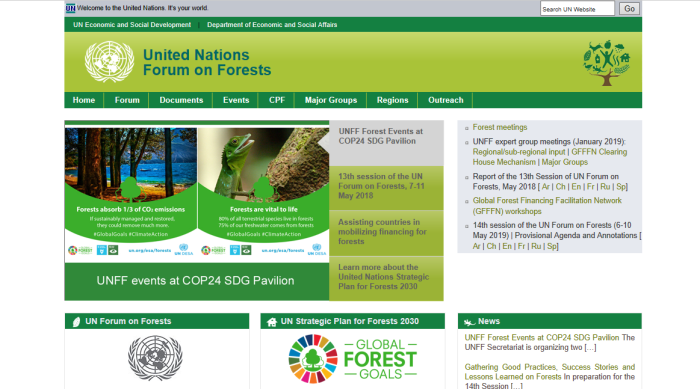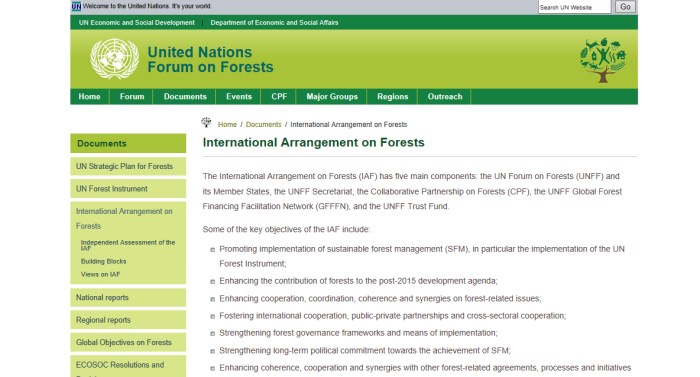

(1) https://www.un.org/esa/forests/index.html
(2) https://www.un.org/esa/forests/documents/international-arrangement-on-forests/index.html
(3) https://www.un.org/esa/forests/documents/un-strategic-plan-for-forests-2030/index.html
(4) https://www.un.org/esa/forests/collaborative-partnership-on-forests/index.html
(5) http://www.cpfweb.org/47318-05366ac58ffc533300f705a3ef2533810.pdf
(6) https://www.un.org/esa/forests/major-groups/index.html
(7) https://documents-dds-ny.un.org/doc/UNDOC/GEN/N04/383/10/PDF/N0438310.pdf?OpenElement
LEGAL FRAMEWORK SOUGHT
CLICK HERE, the mandate for developing a legally binding framework (2004)
You suckers thought this was “voluntary”?
CLICK HERE, for the “non-legally binding” legal framework.
The United Nations wants to globally regulate forests as well.
What “don’t” they want to regulate?
What areas of nationhood “don’t” they want to control?
International Arrangement on Forests
The International Arrangement on Forests (IAF) has five main components: the UN Forum on Forests (UNFF) and its Member States, the UNFF Secretariat, the Collaborative Partnership on Forests (CPF), the UNFF Global Forest Financing Facilitation Network (GFFFN), and the UNFF Trust Fund.Some of the key objectives of the IAF include:
1/ Promoting implementation of sustainable forest management (SFM), in particular the implementation of the UN Forest Instrument;
2/ Enhancing the contribution of forests to the post-2015 development agenda;
3/ Enhancing cooperation, coordination, coherence and synergies on forest-related issues;
4/ Fostering international cooperation, public-private partnerships and cross-sectoral cooperation;
5/ Strengthening forest governance frameworks and means of implementation;
6/ Strengthening long-term political commitment towards the achievement of SFM;
7/ Enhancing coherence, cooperation and synergies with other forest-related agreements, processes and initiatives
Note: It is worth pointing out that many of these UN initiatives have very detailed, lofty goals. However, when it comes to “implementation details”, they get very fuzzy.
Does the UN not know how they will implement their agendas? Would they just rather not say? Are they worried about the consequences of posting “written evidence” on their website?
What about the policy document?
Name
The name of the partnership is the Collaborative Partnership on Forest, hereinafter referred to as the CPF or the Partnership.
Mission
The mission of the CPF is to help enhance the contribution of all types of forests and trees outside forests to the 2030 Agenda for Sustainable Development and other internationally agreed development goals, promote the sustainable management of all types of forests and to strengthen long-term political commitment to that end.
Functions
The core functions of the CPF are to: support the work of UNFF and its member countries; provide scientific and technical advice to the Forum and governing bodies of other CPF members, at their request; enhance coherence, cooperation as well as policy and programme coordination at all levels, including through joint programming and the submission of coordinated proposals to members’ governing bodies, consistent with their mandates; promote the implementation of the UN Forest Instrument and the United Nations Strategic Plan for Forests as well as the contribution of forests and trees to the 2030 Agenda for Sustainable Development and other major forest-related agreements.
Membership
The Collaborative Partnership on Forests currently consists of fourteen international organizations, institutions and secretariats (hereafter referred to as CPF members), that have substantial programmes on forests. Members have considerable capacity to deliver on CPF’s core functions. It is widely recognized that no single body or organization has the capacity or mandate to respond to the multiple demands of forests in a comprehensive manner. Collectively, CPF members, building on their comparative advantages, support the implementation of sustainable forest management worldwide.
The Partnership may periodically review its composition vis a vis its evolving mandate and decide on changes in its membership or establish temporary arrangements for the involvement of third parties to expand its capacities as needed.
Also Worth A Look, The “Major Groups”
The following Major Groups were identified in Agenda 21:
A/ Business and Industry
B/ Children and Youth
C/ Farmers
D/ Indigenous People
E/ Non-governmental Organizations (NGOs)
F/ Local Authorities
G/ Scientific and Technological Community
H/ Women
I/ Workers and Trade Unions
Again, all part of Agenda 21
(a) Business & Industry — this is to be expected, but more information would be nice on their role and expected compensation
(b) Children & Youth — Will there be child labour, or are children expected to specifically benefit?
(c) Farmers — Need more information
(d) Indigenous people — Need more information
(e) NGOs — this is perhaps the most interesting, since NGOs are notorious for flouting national law (think the human smugglers into Europe)
(f) Local authorities — to be expected
(g) Scientific community — the same ones pushing the climate change scam?
(h) Women — So, gender quotas?
(i) Workers & trade unions — Won’t that be a new form of take over?
While this all sounds great, some questions need to be asked:
1/ Will this “forest management” be happening in all countries?
2/ How will the funding be provided? (Specifically, with details)
3/ Who will oversee this?
4/ What if a national government decides participation is against its own interests?
5/ Will blocs of nations be able to “outvote” others?
This has been going on for decades, yet this is the first I am hearing about it?!?!
Discover more from Canuck Law
Subscribe to get the latest posts sent to your email.
